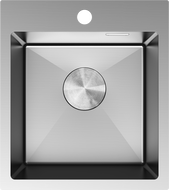
If you have ever opened your kitchen cabinet and suddenly been swarmed by a flock of food moths, you know what a problem it is. These small insects can quickly destroy entire supplies of dry food. Just a few food moths unknowingly brought home in a package of flour or groats, and within a few days, you will find them practically everywhere. Food moths are not only an aesthetic problem but also a real threat; these small pests can carry pathogenic microorganisms, including strep bacteria that cause a range of diseases. Discover our methods for dealing with food moths!
Food Moths – Where Do They Come From?
Food moths are most commonly brought into the house by ourselves. Eggs or even larvae can be found in loose products that we buy both in stores and at markets. Flour, pasta, nuts, groats, rice, dried fruits, dried mushrooms, etc.; any of these products can potentially hide a nest of food moths. Unfortunately, we usually only notice them when adult specimens start flying out of the cabinet.
Unfortunately, even if you are careful about properly storing food, food moths can still enter your kitchen, flying in through windows or ventilation grates. If they manage to get into the cupboard where you store food, there is a high probability that it will end in a food moth invasion. Fortunately, there are some home remedies to prevent moths from appearing in the kitchen, and we also have effective methods to fight them.
How to Start the Fight Against Food Moths?
In the initial phase, food moths are about a few millimeters in size, making them hard to spot because most species of food moths are white. Even if they have brown heads, in most cases, they are not easy to notice. Therefore, we usually only see the flying insects or occasionally the larvae of food moths. In such a situation, you should take everything out of the cupboards and thoroughly inspect the packaging. If the packaging is intact or the products are in airtight containers, they probably do not contain any fertilized moth eggs and can be safely used.
However, when dealing with paper packaging and improperly closed bags of food products, you will likely have to throw away a significant amount of food. You can try rinsing loose products to remove food moths, but this method is not 100% effective and cannot be applied to all dry foods. The only way to get rid of food moth larvae is to throw away the entire contents of the package.
What are Home Remedies for Food Moths?
Wanting to get rid of pests like food moths, we have a lot of methods at our disposal, including various traps. However, the first step is to thoroughly clean the cupboards where the food moths hatched. The first step is to wash the cupboards very well, preferably with hot vinegar; special attention should be paid when cleaning the corners of the cupboards, as moth larvae nests may be found there. Next, it is good to leave the empty cupboards for a few days, and it is wise to put bay leaves and essential oils in them. Lavender oil works great, as food moths dislike the scent of vanilla, so you can also coat the interiors of shelves with it.
After placing food products back in the cupboard, you can leave a bay leaf in it; this is a solution friendly to human health and deterrent to moths. Later, it is worth remembering to close all containers tightly and regularly check the cupboard with food products because food moths can be unwittingly brought home at any time.
Moths Larvae: Food Moths vs. Clothing Moths – What are the Differences?
If you see a flying insect in the house that resembles a grayish-brown moth, it could be both food moths and clothing moths. They are equally difficult to trace; however, they do not affect the food in your kitchen. Clothing moth larvae prefer textiles instead of food products, especially natural wool. Their destructive nature can cause your favorite scarf or sweater to start resembling a sieve.
Theoretically, food moth larvae and clothing larvae represent two different categories, but they are essentially the same pests, and similar methods work against them. Clothing and food moths can take on different colors; you will find the browner ones in the kitchen, and lighter yellowish ones in the wardrobe. If you are affected by a clothing moth plague, you do not have to get rid of the infected products; it is sufficient to clean them thoroughly using available chemical agents. It is worth remembering that neither food moths will eat your clothes, nor will clothing moths cause damage in the kitchen.


















